Portrait of the Artist as Director: Fellini, Truffaut, and Charlie Kaufman
While writing about Charlie Kaufman’s film Synecdoche, New York (2008) earlier, a film that follows protagonist Caden Cotard’s (Phillip Seymour Hoffman) production of his all-encompassing stage play, I kept being recalled to a much older film, Federico Fellini’s 8½ (1963), which also centers around a director and his mysterious, enormous project.
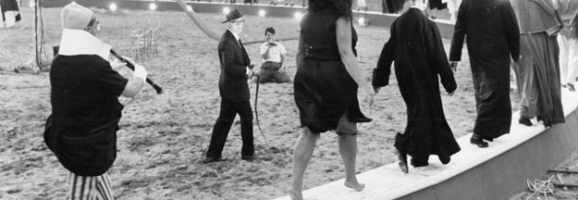
8½ stars Marcello Mastroianni as Guido Anselmi, a famous Italian film director working on his next big hit, a vague science fiction picture. Although Cotard and Guido are working in different mediums (stage versus film), the role of the director is the same, to make order of the grand chaos of reality through the process of production.
A director does not choose to tell “a story within a story” lightly. A hyperreal, metafictional account of the creation process is difficult to convey, and the director must gauge how far he wants to travel into the territory of autobiography.
As the viewer, we wonder how closely related these protagonist directors are to their creators, and what these characters and their creators have to say about the directorial process. In Day for Night (1973), for instance, François Truffaut plays essentially himself as the director of the film within the film. Audiences seem to get a very realistic idea of what directors go through during production and principal photography and see firsthand how Truffaut tackles creating a film.
For Synecdoche, New York and 8½, the lines between fiction and reality are more blurry, and audiences can only speculate how autobiographical they are, though the fact of autobiography has little to do with actual themes.
8½ begins with an allusion to Wagner through the use of “Die Walküre” as background noise, “Ride of the Valkyries” roaring as Guido Anselmi moves through the huge cast and crew, some of which hauntingly address the viewer directly. For Fellini, the cast and crew is an army, rising to the occasion, but the allusion to Wagner refers also to Wagner’s own obsession with directing.
Wagner’s gesamtkunstwerk, a total work of art, a universal artwork that incorporates all art forms into one is an obvious precursor to the genre of film. Wagner saw the theater as the place for a new, sublime religion, one which could accurately get at the heart of a universal and true existence.
Guido struggles to answer any questions about his film, both to the paparazzi and the cast and crew. He seems to have lost interest in the picture completely amid marital troubles, mistresses, and his own vague artistic notions. Throughout 8½, Guido explores visions from his youth, trying to tie his early relationships with religion and sex into his film, but usually comes up empty.
Guido barely works on the film, and ultimately gives it up at the end of Fellini’s film, cashing out before he digs an even deeper grave. Like Wagner, like Caden Cotard, Guido is never satisfied, but rather than motivating him further, he only becomes more disenchanted.
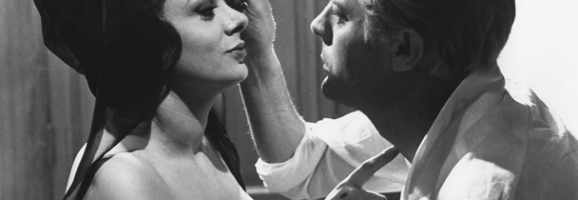
We see a poignant scene where Guido directs a goofy erotic fantasy with his mistress Carla in a hotel room, the only real directing Guido does in the entire film. He later explains that he “wanted to make an honest film…One with no lies,” but his big budget science fiction film, which tries to get at the heart of experience, is an endless loop of futility, too large to make sense of.
Here, in Guido’s bedroom, where he can laugh and make love, is where the truth and honesty are, but he does not realize this. While trying to capture the entire scope of the human condition, Guido’s vision soars right over it, unstable and unproductive.
8½ is full of classical music allusions, but in particular, Nino Rota’s rendition of Aram Khachaturian’s “Sabre Dance,” a wild balancing act, emphasizes the chaos of producing a film, the circus-like atmosphere, the hallucinatory spectacle. For all three directors, Guido, Caden Cotard, and Truffaut as director Ferrand, producing a large, total artwork is chaotic, schizophrenic, and if the director loses his level head and foot in reality, the art can become out of hand, consuming the director whole.
This sounds like an exaggeration, and maybe it is, but the notion is expressed in Caden Cotard’s story to an extreme.
Synecdoche, New York is in many ways about the futility of pursuing an all-encompassing artwork. Caden Cotard, like Guido, wants to create something “big and true and tough,” with an emphasis on being of “unremitting value to [his] community and the world at large.” These words could have been spoken by Guido, and especially by Wagner, but probably not Truffaut.
Cotard receives a MacArthur Fellowship and decides to spend his time and money into an all-encompassing stage play, fitting it in an unrealistically sized warehouse. The impossible warehouse quickly escalates into a world of its own, a realistically sized city full of actors, characters, and real people acting out scenes for Cotard’s play. There are even actors portraying Cotard himself directing the play, one of whom eventually takes over his role as director.
Cotard pushes himself to his limits to create something profound and universal, but drowns in its wide scope. As the theatrical world replaces the real one, and more actors and characters filtrate into Cotard’s existence, he quickly loses his sense of identity and grasp of reality. He wanders a hallucinatory line between reality and the play until his death, his final breath devoted to a new “direction” for the play to take.
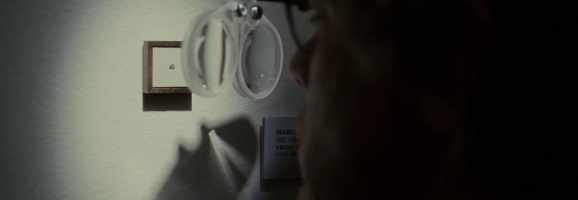
Kaufman emphasizes Cotard’s folly by making Cotard’s estranged wife Adele an internationally successful painter, whose specialty is miniature paintings that require magnifying lenses to see and that offer an unprecedented level of intimacy. Adele’s tiny paintings do not reach for lofty goals, instead choosing to depict small moments in individual’s lives. They are wildly popular and Adele seems satisfied with them. Cotard’s folly is that he aims too big, encroaching into a large inhumanity.
There are many similarities between Synecdoche and 8½, their focus on surreality, a blurred line between reality, memory, and fiction. There is no rhyme or reason as characters, cast members, actors, personal relations, and strangers filter in and out of the films’ eyes, and one can imagine this dreamlike space must parallel what the director actually feels as he answers questions for people he has never seen before.
It must be quite surreal to direct a project of such scale, to direct hundreds of people to recreate reality. Each of the three films features a scene where the director is bombarded by voices and bodies, a plethora of difficult questions that require dedicated answers, questions that barely have no time to be answered. In many ways, this is like a nightmare, exhausting and dance-like.
The wiry grid-like structure of Cotard’s warehouse against the pale sky is an obvious allusion to Guido’s half built, life-sized rocket ship set. Both symbolize their director’s out-of-this-world ambitions, how ultimately hollow and unfinished they are, symbols of futility and their respective director’s sense of grandness and unfaltering ego.
Guido’s rocket ship is poignant in particular, as it ironically embodies progress, travel, and a voyage into the unknown, things Guido’s film strives for but lacks. A rocket ship is a symbol of modern man’s appetite to conquer the universe. Guido’s film is an attempt to recreate this universe, but like the rocket, it is fake, a prop, a hollow promise for greatness.
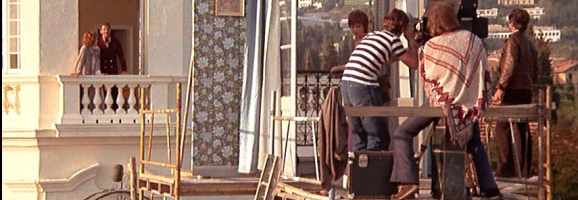
Truffaut’s Day for Night, or La Nuit américaine, its French title, a reference to a filmmaking technique to create the illusion of a night sky, chronicles the production of Je Vous Présente Paméla, a melodramatic film by Truffaut’s fictional counterpart, Ferrand. The film within the film stars several well-known actors and actresses, including aging screen icon Alexandre, played by Jean-Pierre Aumont, who really was an aging screen icon, Jean-Pierre Léaud as a young heart-throb actor, and a young British actress played by Jacqueline Bisset, a tabloid sensation, among others.
The film’s title is a reference to the illusions of cinema, and the film questions whether or not film is more important, or real, than life. Many of the actors and actresses in the film, while not shooting, have their own myriad of melodramatic problems, such as Léaud’s character’s romantic problems that parallel those to his film character’s romantic problems, or Aumont’s character dying in a tragic accident toward the end of production.
Truffaut highlights many of the practical problems that arise while making a full-length film, and audiences get a taste of the surreality that surrounds such a set. While Guido and Caden Cotard go to great lengths to put themselves into their films, Ferrand seems less concerned with a grand truth. Instead, Truffaut seems to argue that cinema is beautiful and that its illusions are part of the magic, tackling practical problems instead of philosophical ones.
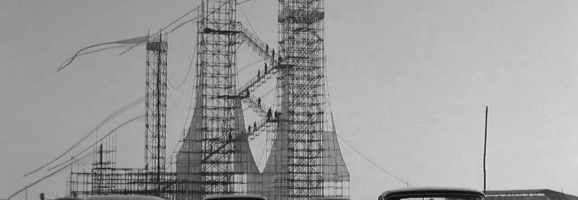
As a way for the real world problems to be resolved and to be given truth and meaning, Ferrand must complete his film. The film itself, the physical art, is emphasized over Truffaut’s feelings as the auteur, a concept he championed.
The film in Truffaut’s film is completed because Truffaut’s director does not become encased in and eventually drown in his own thoughts. Ferrand remains afloat in reality, and never succumbs to his own doubts about art. While Paméla may not be the most artistically inclined film, it is a film with a good amount of humanity and charm, assumedly, and it does get finished.
Guido Anselmi never shows concern for his cast and crew, nor for his lovers and even his wife, and he becomes too easily lost in his own thoughts. He has a vision, but cannot see it to fruition, but he is swift and mature enough to back out of the project when he realizes he is in over his head.
Caden Cotard trusts himself as an artist, but it is this trust and naivety that eventually does him in. He never finishes his project, never even comes close to its total scale, because his scope continually increases until it overwhelms his senses.
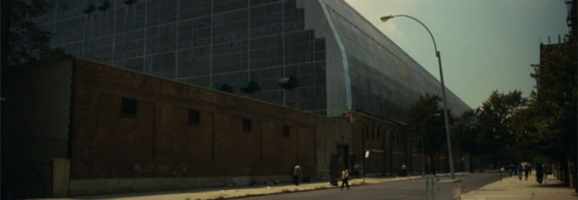
Ferrand is the only one of the trio who finishes his project, and the film’s content can be put into question as having “true artistic merit” if necessary, but Ferrand has a loving bond with the craft of cinema. Day for Night exemplifies Truffaut’s love of film, his trust in it.
When a director chooses to direct a film about a director, he is commenting on film and on art, but also on the human condition and one’s desire to control it. Guido strives to insert his childhood memories into his film, not because he finds them interesting, but to make sense of them. Similarly, Caden Cotard seeks to collect and label everyday roles, to give them meaning and to understand them for himself.
For Ferrand, and Truffaut, film adds new meaning and beauty to reality, and may even be more important than it.
One can’t watch these films without being reminded of Brendon Small’s animated sitcom Home Movies, which centers around eight year-old Brendon and the short films he makes with his friends, much of the humor stemming from his frustration and derision. Brendon’s films are usually directly inspired by iconic scenes from cinema, and they usually parallel what’s happening in his life.
Through an animated, eight year-old lens, film abstracted becomes silly, its futility absurd and humorous. But Guido and Cotard act like children, and they are not so far removed from Brendon’s lofty cinematic ambitions, however impossible. We cannot blame either director for acting childish, for aiming too big, just as we never hold Brendon to any kind of standards.
The visions of a director must be immodest, grandiose, as the director actively recreates the world for his audiences. An artist must know when to be reasonable, though, in order to finish their project. The greatest directors of all-time, Werner Herzog, Francis Ford Coppola, Fellini himself, etcetera, know how to cross this line as subtly as possible
What do you think? Leave a comment.











I’ve always found Truffaut to be the least recognisable of all the filmmakers associated with the ‘new wave’ period.
You can spot a film by Rivette, Godard and Rohmer from a mile away; their themes are always consistent, their style completely unique, full of personal quirks and idiosyncrasies. However, Truffaut, more than any, seemed to spread himself incredibly wide, covering several different genres (from historical films, to melodramas, to science-fiction and Hitchcock parodies) and always adapting his style to fit the material.
His earlier films have the same shot-on-the-streets “reportage-style” that was common in the debut films of Godard and Rivette, but then you get to films like Two English Girls and The Wild Child, or later films like The Green Room and Finally, Sunday! and it’s a completely different feel every time.
One unifying theme throughout his career is the exploration of human relationships, especially those concerning love. Many of his characters are struggling with their love lives, the many forms it can take and the many obstacles in its way. It seems like Truffaut is on a continuous search for some kind of definitive love, one without the pains, yet he always seems to come to the conclusion that there’s always something to obstruct that goal, that it is in fact an impossibility. Childhood love seems to be the most pure form in Truffaut’s cinema, with the children still being innocent, but even that isn’t always without downsides in some of his films.
I too find Truffaut a bit troubling, especially compared to Godard (one of my favorites). I was watching Jules et Jim the other day and found it sort of naive, that it was after this truly naive sense of love. It was a bit more “human” than say Masculine Feminine, but I prefer the attention to aesthetic and style to the latter.
Though Day for Night and the 400 Blows are really great films.
Good write-up!
I think that Kaufman is sort of in the process of imploding as an artist. He’s taken screenwriting and filmmaking to such an abstract level that he’s actually shooting himself in the foot. I think he’s a great writer, but he needs to get out of this metaphysical/philosophical rut that he’s in. It was cool and worked for him in Being John Malkovich or Adaptation or Eternal Sunshine. But once he got around to Synechdoche – which is by no means a bad film – he’d clearly taken things to a far more obscure level that just didn’t maintain the appeal of his previous films. He’s starting to become like a successful musician who makes the same album over and over and over again. Kaufman definitely needs to try something new and drop this whole “tortured artist” schtick.
While I don’t necessarily agree that artists can’t make the same thing over and over, I do agree that Kaufman’s films are further and further being closed off into this abstract box. After Synecdoche, I’m not sure where he can go, so it’ll be interesting to see what he’s writing these days.
Charlie Kaufman has actually been developing a TV series for FX called How and Why. There have even been some recent casting announcements. I wonder how he’ll do with a series format.
Whaat I hadn’t heard of this. FX is pretty great, looking forward to Louie. I’ll have to keep an eye out for this.
It is interesting that these three artists chose to focus their films on the process of making their art with three different outcomes. After reading your great piece, I began wondering what the main characters of each of the films could say about the filmmakers themselves. Specifically, how the characters ended their experiences working on their films. Could that be a tiny window to their process of reaching art? A great piece of writing!
Great article. I feel like Day for Night gets a bad rap for being so joyous about filmmaking and the creation of art, and I’ve spoken to so many people who prefer films like 8 1/2 or Contempt or Stardust Memories because they’re more “critical.”
But few films are as delightful as Day for Night, and although Godard et al may be more respected by scholars, I always admired Truffaut’s willingness to associate with Hollywood and make movies that were (gasp!) entertaining.
Although I prefer to Godard to Truffaut, Day for Night makes Synecdoche and to a lesser extent 8 1/2 seem so…immoral and cynical. It’s a special, kind of magical film.
I liked Fellini and Trauffaut, but I’m leaning more towards Fellini after seeing 8 1/2.
Truffaut’s Antonine Doniel series is my favorite film series by far. These directors make films about directing because they’re also writers, and writers often let autobiographical elements slip into their works.
I think that your comparison between Synecdoche and 8 1/2 is really well crafted, especially in regard to the psychology of artists/directors; it actually makes each of those films seem richer. I really need to see Day for Night after reading this!
This whole discussion makes me think of Stanley Kubrick’s Napoleon, the massive undertaking that he was never able to develop beyond pre-production. I feel that, with this project, he may have suffered from the same Daedalus complex as Caden and Guido. That is, his aims may have been set too unreasonably high. The same argument can perhaps also be made for Jodorowsky’s Dune.
The lesson here is the more exceedingly grandiose something is, the more detached from reality it becomes.